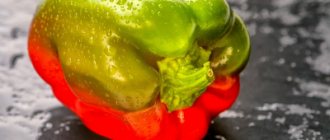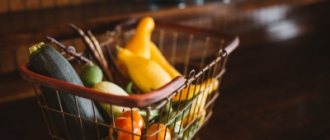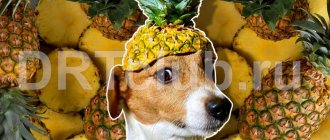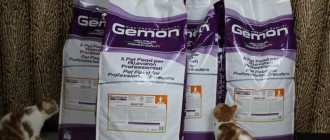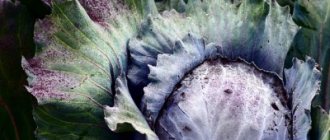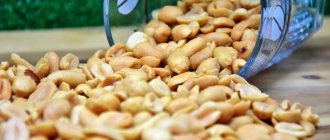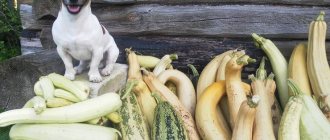Dog breeders often ask the question: “What vegetables can be given to dogs and in what form?” There are many debates and opinions on this topic. Each animal's body is individual. What is good for one may cause an allergic reaction or digestive problems for another.
It is important to gradually add a new product to your food and monitor the body’s reaction. We will figure out which vegetables are safer to start with, and which ones you should be careful with. Give it raw or processed, and how to properly prepare vitamin supplements.
Benefits for your four-legged friend
The most popular cabbage is white cabbage. It contains proteins, fats, carbohydrates, valuable amino acids. The list is supplemented by dietary fiber, chemical elements, vitamins A, C, E, K, PP, group B. While studying cabbage juice, the American biologist Chini isolated a new vitamin U in 1948. Due to its ability to heal wounds on the gastric mucosa, the substance is called anti-ulcer factor.
Other useful properties:
- prevents the formation of malignant tumors;
- strengthens the immune system;
- normalizes fat processes;
- cleanses blood vessels;
- normalizes microflora and improves intestinal motility;
- has an antioxidant and bactericidal effect;
- improves the condition of the skin and coat.
Cabbage is the record holder for the content of tartronic acid. This substance is necessary for the functioning of the nervous system.
Important!
Cabbage is given to dogs that are fed natural food.
The healthiest vegetables for dogs
There are always heated debates between owners, veterinarians and breeders about which vegetables are best to feed the dog.
The fact is that the body of each animal is individual. Those foods that are enjoyed by some will cause numerous problems for others. But there are healthy vegetables that are suitable for all pets and do not cause side effects. These include pumpkin, zucchini, carrots, cucumbers, cauliflower, and bell peppers.
Carrot
Leader in usefulness and digestibility. Includes a large amount of fiber, vitamins A, D, B, micro- and macroelements, beta-carotene.
Veterinarians advise accustoming your puppy to carrots from the first months of life. Raw root vegetables perfectly clean teeth, massage gums, and help relieve itching when changing from a milk bite to a permanent one.
And if the dog likes the orange vegetable, it can be used as a reward during training.
cucumbers
Beneficial for all pets, and most pets eat them with pleasure. They are low in calories and contain almost no carbohydrates or fat.
But they contain a lot of magnesium, potassium, copper, cobalt, vitamins B, C, K.
If you regularly include cucumbers in your dog’s diet, it will strengthen its immunity and normalize brain and central nervous system function.
Pumpkin
Natural antioxidant. Normalizes intestinal function, reduces the acidity of gastric juice, stabilizes the functioning of the liver, and helps cope with constipation. And dogs simply adore it for its sweet taste.
Pumpkin contains vitamins A, B5, C, E, large amounts of cobalt, potassium and copper.
It helps strengthen the immune system, lowers blood sugar levels and improves the breakdown of fats.
Zucchini
Zucchini is an excellent source of vitamin C, calcium, potassium, folate, manganese, iron, and beta-carotene. It is hypoallergenic, improves the functioning of the cardiovascular, hematopoietic, respiratory and nervous systems.
Zucchini is especially useful for pregnant bitches. They contribute to the proper formation of fetuses, supply the expectant mother and puppies with the necessary elements.
bell pepper
Perfect if you need to diversify the menu of your four-legged pet. It contains a lot of B vitamins and ascorbic acid.
The vegetable strengthens teeth and bones, normalizes amino acid metabolism. It is best to give red pepper. It contains the maximum concentration of necessary elements.
But a green or yellow vegetable will also work.
Cauliflower
Unlike other varieties, cauliflower does not ferment. It contains little coarse fiber, due to which the vegetable is easily digested and does not irritate the intestines.
It is recommended to include cauliflower in the diet of dogs suffering from diseases of the urinary system.
Contraindications
Despite its beneficial effect on the gastrointestinal tract, cabbage is given with caution if you have a tendency to flatulence and frequent stomach upsets. Contraindications: enteritis, gastritis, pancreatitis, because the pain increases. Excessive consumption of raw vegetables, even in a healthy dog, will cause increased gas formation. To help the animal, you need to give Espumisan or Smecta. If this phenomenon occurs regularly after eating raw cabbage, it will require heat treatment.
Thyroid hormone deficiency is another contraindication caused by the presence of thiocyanate, which suppresses the functioning of this important endocrine organ. Overeating cabbage causes the development of hypothyroidism in a healthy animal.
Due to the possibility of bloating and indigestion, the consumption of cabbage leaves is limited to pregnant and lactating females. It is better to replace cabbage with dietary varieties.
The benefits of the stalk are questionable. Dogs love to chew it, but it should not be abused due to the increased accumulation of harmful substances coming from the soil and pesticides that are used to treat the crop during cultivation.
Separately about greenery
In general, a dog's digestive system is not designed to digest leafy green vegetables. But, for example, mint can be given for fresh breath, basil has an antimicrobial effect, spinach reduces the risk of cancer, and some other leafy vegetables are antioxidants. Greens have very low nutritional value, so the benefits from them, compared to other vegetables, are negligible, or even none at all. And the pets themselves do not have any particular addiction to greens, especially fragrant ones.
For general development, it should be noted that relatively safe for dogs in small quantities (no more than 1 teaspoon per day) are basil, mint, lemon balm, spinach, lettuce, sorrel, parsley, dill, oregano, rosemary. Parsley should not be given to dogs with kidney problems or pregnant bitches; basil can cause an allergic reaction; lettuce can cause diarrhea.
Similar articles:
- Dry dog food Wolfsblut
- Can a dog have pasta?
- Food for white dogs
- Why doesn't my dog eat dry food?
- Dog food Now
- Probiotics for dogs
Other types of cabbage
The usual white cabbage can be replaced with other species that are not inferior in taste and nutritional value. These include:
- Chinese cabbage. Dogs love this variety for its tender and juicy leaves. It contains magnesium, calcium, amino acids. The vegetable puts little strain on the gastrointestinal tract. Low fiber content does not cause flatulence. Peking cabbage is given fresh.
- Colored. Contains a lot of vitamin A (beta-carotene), C, D, folic acid, potassium and calcium. Due to its easily digestible protein and small amount of coarse fiber, it is classified as a dietary variety. In moderate quantities, cauliflower is given without fear to weakened and old animals. It does not cause allergies or flatulence. It is recommended to serve boiled, stewed or steamed.
- Broccoli. Also a dietary variety, served raw and boiled. Contains more carotene than cauliflower or white cabbage. Do not give to dogs with thyroid deficiency and a tendency to allergies.
- Brussels. This variety has a high content of vitamin C, magnesium and potassium; it is preferable to give it raw. Cook Brussels sprouts with lemon juice. Despite the low calorie content, the product is nutritious.
- Savoy. It is also a storehouse of vitamins and minerals, but also biologically active substances, which is why this variety is not recommended for gastric pathologies.
- Red cabbage. This type is one of the most useful. The nutritional value is higher than that of green varieties, 10 times more vitamins. Flavonoids, which give the plant its red-violet color, counteract the development of oncology and increase the body's resistance to diseases.
Among the varieties of this vegetable, there is no variety that cannot be given to dogs unless there is an allergy to this product or other contraindications.
Do dogs need plant foods?
Dogs are predators. Therefore, their diet should consist of 80% meat and dairy products.
But dogs are not obligate carnivores. Their ancestors did not feed exclusively on animal foods. In the wild, wolves and jackals often eat berries, mushrooms, grass, and tree bark.
In addition, wolves eat the intestines of captured animals. It contains semi-digested plant products.
Therefore, vegetables must be included in the daily menu of dogs. They:
- contain vitamins, minerals and other beneficial elements that are not found in animal products;
- stimulate peristalsis, improve digestion;
- clean teeth from plaque, massage gums.
A dog won't last long on meat alone. Gastrointestinal disorders, chronic constipation and vitamin deficiency are guaranteed for him. A balanced diet must include foods rich in fiber.
In what form to give
There is disagreement on this issue. In fact, for a healthy adult animal there is no problem here. The vegetable is given both raw and after heat treatment. In the first option, vitamins are better preserved, the intestines are cleansed, and tartar is removed. After heat treatment, the content of vitamin C increases, beta-carotene is better absorbed, and the effect of thiocyanate, which causes hypothyroidism, is neutralized.
Dogs with gastric pathologies should not be fed raw cabbage because it irritates the stomach walls. It is boiled, stewed, baked separately and with other vegetables. The most successful heat treatment option is steaming, which preserves most of the beneficial substances. Sometimes you have to grind it with a blender or grind it in another way, warm it up to 37 ° C before feeding: warm and soft, it binds more easily to gastric enzymes and is digested faster. For puppies, a pinch of cabbage is added to soup, boiled with cereals, and stewed with meat. In its raw form, previously chopped with a knife, it is added to the porridge.
Why cut cabbage finely if the dog crushes it with his teeth? Broccoli and kohlrabi are given whole, white cabbage and Peking kohlrabi are cut into pieces. Grinding on a grater or in a blender is only necessary for puppies, weakened and old dogs. The resulting mass is flavored with vegetable oil, mixed with porridge, minced meat, and sprinkled with kefir and sour cream. They do the same during the transition from dry food to natural food: a pet that is not accustomed to new products will choose meat, leaving the vegetable in the bowl.
Important!
The form of serving cabbage is alternated: finely chopped, cubes, pieces, grated, raw and after heat treatment.
From the above, the conclusion suggests itself: a healthy adult dog should be given any cabbage: raw, boiled, stewed, fresh, pickled, but all in moderation.
Harmful and prohibited
There are vegetables that absolutely should not be given to dogs. They are useless, and some of them are poisonous and, when fed, can lead to intoxication and abnormalities in the functioning of internal organs and systems.
These vegetables include:
- Corn.
It is nutritious and contains a lot of fiber and protein. And also cheap. Because of this, it is often added to dry foods, even those that belong to the super-premium class. But dogs don't have the enzymes to break down corn kernels and they pass through.- Potato.
Raw root vegetables contain the toxic substance solanine, while boiled or baked ones contain a lot of starch and carbohydrates. They increase cholesterol levels and cause obesity.- Legumes.
Just like corn, they are not digestible by dogs. In addition, they irritate the walls of the stomach and intestines and provoke gas formation.- Mushrooms.
Even non-poisonous varieties absorb heavy salts and toxic elements. They also contain chitin, which has a negative effect on the digestive system.- Onion and garlic.
Contain thiosulfates, which destroy blood cell membranes. Over time, this can cause anemia.
If the dog steals a couple of pieces of potatoes, mushrooms, onions or a few grains of corn, nothing bad will happen to him. But you cannot intentionally and constantly give your dog these vegetables.
How much to give
Cabbage is a healthy crop, but it should not form the basis of the diet and replace other vegetables. If your pet eats greedily and asks for more, it means that the body is experiencing a deficiency of some substances, which is replenished by cabbage. In this case, the portion is not increased, but given daily.
It is difficult to give the serving size of the vegetable in question in grams, since this value depends on the weight and age of the animal. When calculating, it is taken into account that the total amount of vegetables does not exceed 1/5 of the diet, but this cannot be cabbage alone.
Is it important to add vegetables to your pet's diet?
By its wild nature, a dog is a predator. The basic component of the diet should contain 70–80% animal protein. These can be meat products, dairy products, eggs, fish. The remaining percentage includes vegetables and grains.
Even a wolf does not disdain herbs, the roots of some plants, and berries. The favorite delicacy in the carcass of herbivores is the stomach. Semi-digested vegetation helps process the meat eaten by the predator.
Vegetables are rough fiber that mammals need. Their slow carbohydrates form a prebiotic environment that increases the digestibility of animal proteins.
Composition value of vegetables:
- minerals;
- organic acids;
- folic acid;
- vitamins P and C;
- phytoncides;
- beta-carotene;
- magnesium;
- potassium.
Phytoncides fight dangerous microorganisms, and acids have a positive effect on the digestion process.
Plant protein from vegetables forms new cells in the body. The digestive system of dogs is quite limited, so plant foods are partially digested. Undigested vegetable parts in animal feces are common. At the same time, fiber is an excellent stimulator of intestinal function. It also cleanses the body of excess cholesterol.
Why feed your dog vegetables?
According to Bridget Meadows, head of nutrition at dog food company Ollie, it's safe to feed dogs vegetables as long as their diet contains between 40 and 70 percent protein. Protein can be plant-based (such as legumes), but the most common ideal forms of protein are muscle meat, organ meats, and eggs.
Brett Podolsky, co-founder of The Farmer's Dog, a service that offers balanced, fresh pet food made with real ingredients and simple recipes, says vegetables should not make up more than 10 percent of a dog's diet. But that 10 percent can add significant nutrients that proteins can't offer.
“Vegetables are an excellent source of hydration due to their high water content,” says Podolsky. “They can also provide your dog with a range of vitamins, minerals, antioxidants, fiber and phytonutrients, which are natural compounds found in plants that have disease-fighting potential.”
© shutterstock
Of course, how much of your dog's diet consists of vegetables will depend on your puppy's activity level, age, breed, health concerns, and veterinarian recommendations. For example, your veterinarian may recommend replacing standard dog treats with carrots and apples if your dog needs to maintain a healthier weight.
As with any healthy diet, your dog should eat a variety of foods to maintain a balanced diet. And don't apply human recommendations to your canine friends! Although humans consume spices and seasonings, they can irritate your dog's stomach. And while you can eat a vegan and grain-free diet, dogs need plenty of protein and healthy grains. In fact, grain-free diets are not suitable for dogs.
Daily cabbage soup from sauerkraut
Hi all! It's getting colder and the time has come for good, hearty, rich soups; my choice definitely fell on sauerkraut cabbage soup. During the autumn and winter period I make them 2-3 times, each time confirming that this soup is one of the best in Russian cuisine. The combination of meat broth, sauerkraut stewed in melted butter, simple spices such as black pepper and bay leaves create a simply amazing combination of smells, so to speak, “the Russian spirit is here, it smells like cabbage soup.” In general, cabbage soup is essentially a unique symbol of Russian national identity, just like black rye bread, a samovar, and maybe even kvass or vodka. Representatives of all strata of Russian society, from peasants to the royal family, did not hesitate to admit their love for cabbage soup. Alexander Suvorov generally ate exclusively cabbage soup and porridge, and this simple “cabbage soup and porridge” helped him and his “miracle heroes” achieve many significant victories. victory. The lyrical-patriotic digression is over. So let’s take it:
1) sauerkraut – 2 kg 2) carrots + onions, 2 pcs. 3) celery root - 1 pc. 4) parsnip - 1 pc. (I took it to the heap, the merchant persuaded me, she says you won’t regret putting it in the soup) 5) parsley root - 2 pcs. 6) turnip - 2 pcs. + tomato 3 pcs. 7) salted mushrooms (I have saffron milk caps and milk mushrooms) melted butter 100g 9) beef brisket 2 kg 10) garlic, black peppercorns, bay leaves, herbs 11) A bottle of horseradish according to the beaver recipe (for the cook and assistant)
3) celery root - 1 pc. 4) parsnip - 1 pc. (I took it to the heap, the merchant persuaded me, she says you won’t regret putting it in the soup) 5) parsley root - 2 pcs. 6) turnip - 2 pcs. + tomato 3 pcs. 7) salted mushrooms (I have saffron milk caps and milk mushrooms) melted butter 100g 9) beef brisket 2 kg 10) garlic, black peppercorns, bay leaves, herbs 11) A bottle of horseradish according to the beaver recipe (for the cook and assistant)
First, add chopped celery root, parsley, parsnips and turnips to one cast iron pot, add cabbage with brine, 100 grams of melted butter and put in the oven for three to four hours. In another cast iron pot we put the meat with onions, carrots and parsley root, pour water and also put it in the oven.
Slowly, you can chop the onions, carrots and all the remaining roots and begin to simmer everything with tomatoes. Then we drink the first 100 grams. signature “Bobrovskaya” horseradish (in vain we read recipes in FZ).
My mood noticeably improves, warmth spreads throughout my body, I feel a surge of energy and strength, and the process of removing bad cholesterol begins. Three hours have passed... I no longer have any supplies of crap, they ran out surprisingly quickly, I feel like crap, but I’m still holding on. It’s unclear why they didn’t stop at the second one? It drinks easily and pleasantly, but then for some reason your legs stop working, your speech becomes chaotic and incoherent, a feeling of euphoria sets in, and an irresistible desire arises to open another bottle. My wife talks about some signs of alcoholism, but I simply don’t believe her and send her to her mother.
Now the contents of two cast iron pots and a frying pan need to be transferred into a large enamel pan, which I inherited from my grandmother, may she rest in heaven, I simply don’t have a larger vessel.
First, strain the meat broth and cut the meat. Add two heads of chopped garlic, peppercorns, bay leaves and herbs. This is also when I add all the mushrooms. I like it spicy, so a tablespoon of adjika won’t hurt. If it turns out very thick, you can add water.
The oven has already cooled down and I’m letting the whole thing simmer until the morning. In the morning I take the pan out of the oven and put it in the cold until tomorrow morning, exactly for a day. That's why cabbage soup is called daily. The next morning comes. I decided to make some elk pies to go with the cabbage soup; I recently caught a cow while hunting.
We fire up the oven and first prepare the pies; they certainly look unattractive, but you try to make them from a hangover in the morning, they look so good.
Pour the cabbage soup into a clean cast iron pot and don’t forget about the meat. I made the lid out of dough, but it started to fall through, so I first put birch splinters on the cast iron, and on top of the dough like a lid. We put everything in the oven for 15-20 minutes.
Well then everything is clear.
Like a hangover soup, I’ll tell you very well, and after two plates and drinking half a bottle of vodka, gnawing on the cartilage suddenly breaks out in sweat and a state of spiritual complacency and serenity sets in, you simply fall asleep for a couple of hours. . I wish you all health, good appetite and take care of your liver from the green serpent.

